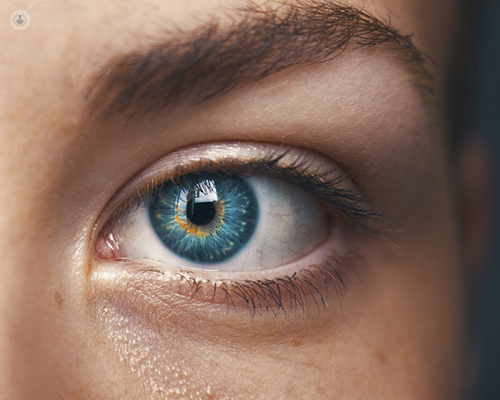Dry eye syndrome: a symptom of meibomian gland dysfunction
Autore:Dry eyes are made up of two main diseases: meibomian gland dysfunction (MGD), which is previously known as blepharitis, and aqueous layer deficiency. The former is about 80% of dry eye and the latter forms the bulk of the rest. Dry eyes are therefore due to either an oil insufficiency or a water layer deficiency. Leading ophthalmologist Mr Myer Mark Yodaiken explains more about the eye condition MGD and how it leads to its commonest symptom, dry eye syndrome…

What does MGD feel like?
MGD presents itself in various manners and has been described as feeling like:
- Dry and gritty
- Burning, itchy sensation
- Irritable
- Light sensitivity (photophobia)
What is blepharitis (MGD)?
Blepharitis is classified into two types:
Anterior blepharitis – which affects the outside of the eyelid and is caused by infections, deposits and a build-up of waxy scales and hard crusts.
Posterior blepharitis - better known now as meibomian gland disease – is an abnormality in the oil glands, found on the inner eyelid reducing an abnormal oil layer. It also occurs as a result of a skin condition such as acne or rosacea. The lack of oil leads to an increase in evaporation and inflammation that leads to the onset of evaporative dry eye, the most common form of dry eye syndrome.
How is it diagnosed?
To diagnose blepharitis and more severe cases of MGD the eye specialist will use a microscope, called a slit lamp. Mild versions of the disease need special photography through the use of a tool called Lipiview, which measures the oil layer. This checks if the oil has decreased and photos of the meibomian gland show if there are any underlying damage and loss to the glands.
Who develops dry eyes and can it be prevented?
Traditionally, dry eyes are more common in women and in the elderly. It is, however, fast becoming an epidemic because of the use of computers. After staring at a screen all day, people blink frequently, which leads to stagnation of the oil and therefore the oil can’t get out of the glands.
There is nothing that can be done to prevent dry eyes. If using a computer all day it is recommended to take frequent breaks from staring at the screen. We (ophthalmologists) can measure your blink rates and check if you have a partial blink contributing to the disease process. In fact, nowadays our Lipiview technology which takes specialised photographs can help us make this diagnosis more accurately.
How is it treated?
Anterior blepharitis can be mainly cleaned at home with wipes, or in the doctor’s office with a machine called Blephex.
Posterior blepharitis is much more complicated to treat. The gold standard of treatment is a computer-controlled machine called Lipiflow. The device fits over both the eye and eyelid, which allows it to apply both heat and pressure. The heat and pressure are delivered simultaneously to the correct area and is computer controlled giving precise control over the treatment process better than the guesswork achieved by other treatment modalities such as heat bags.
Other treatments include microwave heat bags that can be used at home or other similar heat procedures. Occasionally the patient will also have a course of antibiotics.
Can meibomian gland dysfunction be cured?
The condition cannot be cured but it can be controlled significantly. In up to 80% of patients, there is an improvement in symptoms, particularly after Lipiflow treatment. Even in 20% of cases where there has been little improvement, there is definitely a reduction in the progression of the disease.


